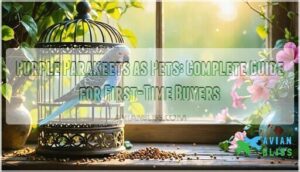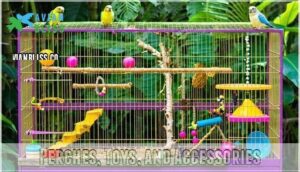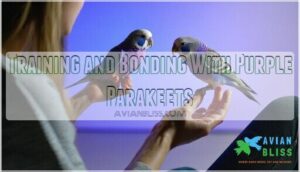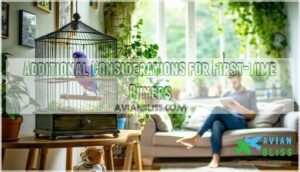This site is supported by our readers. We may earn a commission, at no cost to you, if you purchase through links.

You’ll find these vibrant birds combine stunning plumage with gentle temperaments, making them ideal starter pets for bird enthusiasts.
They’re social creatures who thrive on interaction, requiring a balanced diet of seeds, pellets, vegetables, and fruits available at most pet stores.
While their compact size might suggest low maintenance, purple parakeets actually need thoughtful care including proper housing, regular enrichment, and social engagement to flourish.
Their intelligence and trainability make them rewarding companions who can learn tricks and form strong bonds with their owners, which is key to understanding their specific needs.
The key lies in understanding their specific needs, from cage setup to feeding schedules, which transforms pet ownership from guesswork into a genuine partnership with a deep sense of companionship and beauty.
Table Of Contents
- Key Takeaways
- Origins, Colors, and Markings
- Temperament and Behavior of Purple Parakeets
- Diet and Nutrition for Purple Parakeets
- Health and Care for Purple Parakeets
- Exercise and Enrichment for Purple Parakeets
- Housing and Cage Setup for Purple Parakeets
- Training and Bonding With Purple Parakeets
- Additional Considerations for First-Time Buyers
- Frequently Asked Questions (FAQs)
- Are purple parakeets good pets?
- Where can I buy a purple parakeet?
- How does a purple parakeet get its color?
- How long do purple parakeets live?
- Can a purple parakeet be born in the wild?
- What should a purple parakeet be fed?
- Are parakeets good for first time owners?
- What is the lifespan of a purple parakeet?
- What to do when you first buy a parakeet?
- Do purple parakeets need special veterinary care?
- Conclusion
Key Takeaways
- You’ll get 7-15 years of companionship with purple parakeets when you provide proper care, nutrition, and regular veterinary checkups – making them excellent long-term pets for beginners.
- You’ll need to budget $100-600 initially plus $45-85 monthly for food, toys, and maintenance, so plan your finances carefully before bringing home your feathered friend.
- You’ll create a thriving environment by setting up a spacious cage (18" x 18" x 18" minimum), providing daily exercise time, and rotating toys weekly for mental stimulation.
- You’ll build strong bonds through consistent training using positive reinforcement techniques like clicker training and daily social interaction, as these intelligent birds can learn tricks and speech.
Origins, Colors, and Markings
You’ll discover that purple parakeets originated in Australia and arrived in Europe during the 19th century through selective breeding programs.
These stunning birds showcase the violet genetic factor working on a white base color, creating their distinctive purple plumage that’s rarely seen in wild populations.
Origin and History of Purple Parakeets
Purple parakeets trace their Australian roots back to the 19th century when budgerigars first arrived in Europe.
Through selective breeding practices and genetic mutations, breeders discovered stunning color variations impossible in wild populations.
The violet factor became the key to creating these enticing purple parakeets, transforming white-based birds into vibrant violet parakeets through careful parakeet genetics and dedicated parakeet breeding programs.
The Abundance of Colors in Purple Parakeets
Whether you’re captivated by deep violet hues or lighter lavender tones, purple parakeets showcase remarkable plumage variations through sophisticated color genetics.
The violet factor creates these stunning shades by modifying white base colors, producing everything from soft pastels to rich royal purples.
Selective breeding techniques have revealed numerous mutation types, allowing breeders to develop specific violet parakeets with consistent coloration.
Understanding parakeet genetics reveals how these beautiful parakeet colors emerge through careful parakeet breeding programs that combine specific genetic factors to achieve desired results, showcasing the importance of sophisticated color genetics.
Unique Markings and Features of Purple Parakeets
You’ll notice distinctive forehead markings that fade as your purple parakeets age, creating unique identification patterns.
These violet budgie breeding results showcase intricate feather patterns with subtle eye rings and specialized beak colors.
The plumage texture varies between individuals, making each parakeet’s violet parakeet mutation truly one-of-a-kind in your parakeet color guide collection.
Understanding the proper blue parakeet care is essential for maintaining their health and unique characteristics, which include violet parakeet mutations and require specific blue parakeet care.
Temperament and Behavior of Purple Parakeets
Purple parakeets share the same delightful temperament as their green cousins, making them excellent companions for first-time bird owners.
You’ll discover these colorful birds are naturally social, intelligent, and keen to form strong bonds with their human families, which makes them excellent companions due to their ability to form strong bonds.
Friendly and Affectionate Nature
Your feathered friend will become your devoted companion through their gentle nature and affectionate traits.
These friendly birds develop strong social bonding with owners who invest time in parakeet socialization. Their playful personality shines through daily interactions, offering emotional support and genuine parakeet companionship.
Purple parakeets display remarkable parakeet behavior that makes them ideal pets for those seeking loving, interactive birds with naturally affectionate dispositions and a gentle nature.
Bonding and Social Interaction
Your parakeet’s social bonding needs go beyond simple companionship.
These highly social birds require daily owner relationship building through consistent interaction and attention. Parakeet companions aren’t mandatory, but flock dynamics show they thrive with bird social interaction.
Watch for behavioral cues like beak tapping and synchronized movements that indicate strong parakeet socialization. Meeting their parakeet companionship needs through quality time strengthens your bird bonding experience substantially, which is a key part of parakeet socialization.
Intelligence and Trainability
Beyond forming strong bonds with their owners, purple parakeets showcase impressive cognitive abilities that make them exceptional companions.
Their bird intelligence shines through advanced problem solving skills and remarkable memory retention. These birds demonstrate natural trainability, quickly mastering parakeet training routines through consistent practice.
Here are five key intelligence traits you’ll observe:
- Speech Patterns – They mimic human words and develop unique vocalizations
- Trick Learning – Master complex behaviors like stepping up and target training
- Problem Solving – Navigate puzzle toys and figure out food dispensers
- Memory Retention – Remember daily routines and recognize individual family members
- Bird Behavior – Adapt their actions based on environmental changes and social cues
Their parakeet talking abilities vary by individual, but most learn basic words within weeks of consistent training sessions.
Diet and Nutrition for Purple Parakeets
Your purple parakeet’s diet directly impacts their health, vibrant plumage, and lifespan. Understanding proper nutrition helps you choose between seed-only diets and balanced feeding approaches that support ideal wellness.
Seed-based Diet Vs. Balanced Diet
Understanding the difference between seed-based and balanced diets will reveal better health for your purple parakeet.
Seeds alone create nutritional gaps, lacking vitamin A, calcium, and essential amino acids your bird needs. This imbalance leads to obesity, weak immunity, and shortened lifespans.
A balanced diet transforms your parakeet’s well-being through proper nutrient balance and food variety:
- Pellet Benefits: High-quality pellets provide complete nutrition that seed-based diets can’t match
- Diet Plans: 60-70% pellets, 20-30% fresh produce, 10% seed options maximizes parakeet nutrition
- Bird Nutrition: Balanced approaches mirror wild feeding patterns, promoting natural foraging behaviors
Smart parakeet diet choices prevent deficiencies while supporting vibrant feathers and active lifestyles.
A well-planned seed mix guide is essential for maintaining superior health in parakeets.
Recommended Foods and Supplements
Your purple parakeet’s diet should center on high-quality pellet diets, which provide balanced nutrition that seed-only options can’t match.
Fresh fruits like berries and melons offer vitamins, while calcium supplements such as cuttlebones support bone health.
Include safe vegetables like leafy greens and sweet potatoes for variety, and limit fatty seed options to 10% of their total intake to prevent obesity.
This nutrient balance approach guarantees your bird receives proper parakeet nutrition without the deficiencies common in traditional seed-based diets, by following a proper parrot diet plan.
Quality bird nutrition means combining commercial pellets with fresh produce for peak health, and a well-planned parrot food nutritional guide helps prevent common health issues, ensuring a long and healthy life for your pet.
Feeding Schedule and Portion Control
For ideal parakeet care, establish consistent meal timing with fresh food offered twice daily.
Your purple parakeet thrives on routine, so maintain regular feeding schedules that support their natural foraging instincts.
Monitor food portions carefully—small birds need balanced nutrition without overfeeding.
- Daily Feeding Strategy: Provide 1-2 tablespoons of pellets per bird, supplementing with fresh fruits and vegetables that comprise 20% of their diet while ensuring constant water intake for proper nutrient balance.
Health and Care for Purple Parakeets
Your purple parakeet’s health directly impacts their quality of life and your experience as a pet owner.
Proper care involves understanding their 7-15 year lifespan, recognizing common health issues, and establishing regular veterinary routines to ensure a healthy and happy pet, with proper care being essential.
Lifespan and Common Health Issues
Your purple parakeet’s lifespan typically ranges from 7 to 15 years, with exceptional care extending it to 20 years.
Parakeet longevity depends on genetics, nutrition advice, and disease prevention.
Common health problems include psittacosis, tumors, and nutritional deficiencies.
Bird health suffers from seed-only diets lacking essential vitamins.
Parakeet health issues like obesity and respiratory infections are preventable through proper care.
Regular monitoring helps identify health risks early, ensuring your feathered friend lives their fullest life.
To keep your parakeet healthy, understanding parakeet care is essential for providing the right environment and nutrition.
Veterinary Care and Regular Check-ups
Since your purple parakeet can’t tell you when something’s wrong, annual vet visits become your bird’s voice for health concerns.
Schedule preventive care checkups every six to twelve months to catch parakeet health issues early.
Your avian veterinarian will perform medical tests, examine droppings, and assess overall bird health.
Emergency care becomes necessary if you notice breathing problems or appetite changes.
Regular veterinary checkups help establish baseline health data, making future health checks more effective for detecting problems before they become serious.
Cage Setup and Maintenance
Beyond veterinary checkups, maintaining a clean parakeet cage keeps your purple companion healthy and happy.
Your bird cage setup requires weekly deep cleaning with mild soap and water to remove waste and debris. Daily spot-cleaning prevents bacteria buildup between thorough cleanings.
Here’s your cage maintenance checklist:
- Weekly deep clean – Remove everything, scrub bars, and replace bedding completely
- Daily spot checks – Clean water dishes, remove uneaten food, and check for wear
- Monthly inspections – Examine bar spacing, perch placement, and toy rotation needs
Pet bird cages need proper ventilation and strategic perch placement at varying heights. Rotate toys monthly to prevent boredom, and check nesting boxes regularly for cleanliness.
Your cage cleaning routine directly impacts your bird’s health and longevity. When selecting a cage, consider the importance of suitable parakeet cages to guarantee your bird’s environment is safe and comfortable.
Exercise and Enrichment for Purple Parakeets
Your purple parakeet needs daily exercise to stay healthy and prevent behavioral problems like feather plucking or aggression.
Creating an enriched environment with varied toys, climbing opportunities, and mental challenges keeps your bird physically active and mentally engaged.
Your bird’s environment should include daily exercise to prevent issues.
Importance of Physical Activity
Daily flight benefits your purple parakeet’s cardiovascular health and muscle development.
Exercise needs include at least two hours of supervised out-of-cage time for physical stimulation. Activity levels should mirror wild parakeets’ natural fitness requirements.
Flying strengthens wings while preventing obesity-related health issues in these energetic birds.
Providing a Stimulating Environment
Beyond basic exercise needs, your purple parakeet requires environmental enrichment to thrive mentally and physically.
Create stimulating spaces that encourage natural behaviors and prevent boredom-related problems.
Transform your bird’s world with these enrichment strategies:
- Cage Design: Arrange perches at varying heights with different textures and diameters
- Toy Rotation: Switch toys weekly to maintain novelty and prevent habituation
- Sensory Play: Introduce safe materials like paper strips, untreated wood blocks, and foraging opportunities
Environmental enrichment goes beyond simple parakeet care—it’s about creating interactive play experiences that mirror wild behaviors and promote bird exercise.
Toys and Activities for Mental Stimulation
Purple parakeets thrive with diverse bird toys that challenge their minds.
Swing toys provide physical activity while puzzle feeders encourage natural foraging games.
Interactive toys like puzzle toys stimulate problem-solving skills during interactive play.
Create sensory play opportunities with different textures and sounds.
Rotate toys weekly to maintain interest and prevent boredom, ensuring your bird receives proper mental stimulation and bird exercise.
Providing a stimulating environment requires understanding of parrot enrichment techniques to keep your parakeet happy and healthy, with a focus on parrot enrichment techniques.
Housing and Cage Setup for Purple Parakeets
Your purple parakeet needs a properly sized cage with the right accessories to thrive in your home.
Your feathered friend deserves a home that supports their natural behaviors and keeps them healthy and happy.
The cage setup directly impacts your bird’s physical health, mental stimulation, and overall happiness.
Cage Size and Design Considerations

Your purple parakeet needs adequate space to spread their wings and exercise properly.
Choose a cage at least 18" x 18" x 18" for one bird, with horizontal designs supporting natural flight patterns.
Bar spacing shouldn’t exceed 0.5 inches to prevent escapes or injuries.
Consider cage depth for comfortable perch placement and make certain proper door size for easy access.
Good ventilation prevents respiratory issues while supporting your bird’s health and comfort.
When selecting a cage, understanding cage size requirements is vital for the well-being of your purple parakeet, and it’s essential to have a proper door size.
Perches, Toys, and Accessories

Since furnishing your purple parakeet’s cage properly guarantees their happiness and health, you’ll want to select the right perches, toys, and cage accessories carefully.
When choosing perches, consider the importance of parakeet perches for their foot health.
- Perch Materials: Choose natural wood branches with varying diameters to exercise different foot muscles and prevent arthritis
- Toy Rotation: Swap out interactive play items weekly to maintain mental stimulation and prevent boredom
- Swing Sets: Install bird ladders and swings at different cage levels for climbing exercise and entertainment
Creating a Safe and Comfortable Environment
Creating a secure parakeet habitat requires attention to multiple environmental factors that directly impact your bird’s well-being.
Your cage setup should prioritize both physical safety and psychological comfort through thoughtful cage design and environmental enrichment strategies.
Creating A Safe Haven
- Design the cage to be spacious enough for flying without overcrowding.
- Confirm bar spacing is narrow enough to prevent escape or injury.
- Place perches at varying heights to encourage exercise and movement throughout the day.
Essential considerations for ideal parakeet care include:
- Temperature regulation maintains consistent warmth between 65-75°F, protecting your bird from drafts and extreme fluctuations
- Lighting control provides 10-12 hours of natural or full-spectrum light daily, supporting healthy sleep cycles and vitamin D synthesis
- Noise reduction creates a calm environment by positioning the cage away from high-traffic areas and loud appliances
Your parakeet’s social needs flourish when their habitat feels secure and stimulating, promoting natural behaviors and reducing stress-related health issues.
Training and Bonding With Purple Parakeets
Training your purple parakeet requires patience and consistency to build a strong bond with your feathered friend.
You’ll discover that these intelligent birds respond well to positive reinforcement techniques and can learn impressive tricks when you establish trust through regular interaction.
Building Trust and Establishing a Bond
Once you’ve set up your purple parakeet’s home, building trust becomes your next priority.
Your feathered friend needs time to adjust and feel secure with you.
Start with these foundational approaches:
- Gentle handling – Move slowly around the cage and speak softly to avoid startling your bird
- Social bonding through consistent daily interaction and offering treats from your hand.
Trust building happens gradually through regular play interaction and respecting your parakeet’s boundaries.
Your purple parakeet’s social needs include attention and owner connection, so patience during this process strengthens your pet bonding relationship substantially.
Teaching Tricks and Behaviors
Once your purple parakeet trusts you, bird training becomes an exciting adventure. These intelligent birds excel at learning through consistent practice and patience.
Trick Training starts with simple commands like "step up" before advancing to complex behaviors. Clicker Training marks correct actions precisely, while Speech Lessons require daily repetition of clear words. Behavior Modification shapes unwanted habits through redirection, and Agility Exercises challenge their problem-solving abilities.
| Training Type | Difficulty Level | Time Required | Success Rate | Best Age |
|---|---|---|---|---|
| Step Up | Beginner | 1-2 weeks | 95% | Any age |
| Target Training | Intermediate | 2-4 weeks | 85% | 3+ months |
| Speech Commands | Advanced | 1-3 months | 60% | 4+ months |
| Trick Sequences | Expert | 3-6 months | 40% | 6+ months |
| Flight Recall | Expert | 6+ months | 30% | 8+ months |
Training techniques work best with short, frequent sessions. Your bird’s trainability shines when lessons stay fun and rewarding.
Positive Reinforcement Techniques
After establishing trust, you’ll release your parakeet’s full potential through effective positive reinforcement.
Reward systems using treats, praise, and clicker training create powerful learning opportunities. This approach builds on operant conditioning principles that make behavior modification both natural and enjoyable for talking birds.
- Clicker Training: Use consistent clicks followed by immediate rewards to mark desired behaviors
- Social Learning: Practice training sessions during natural social interaction periods for better results
- Reward Timing: Deliver treats within three seconds of correct behavior for maximum effectiveness
- Consistency: Maintain regular training schedules to reinforce your bird’s natural trainability patterns
Additional Considerations for First-Time Buyers
Before bringing home your purple parakeet, you’ll need to budget for ongoing expenses and research trustworthy sources.
Consider your household’s specific needs, including potential allergies and space requirements that could affect your bird’s well-being.
Cost and Budgeting for Parakeet Care
Purple parakeet ownership requires careful financial planning.
Initial costs range from $100-$600, including the bird ($30-$300) and setup expenses. Monthly expenses average $45-$85, covering food, toys, and maintenance.
Consider these budget categories:
- Initial Costs: Bird purchase, cage ($30-$200), and accessories ($40-$90)
- Monthly Expenses: Food budget ($10-$30), toy replacement, cleaning supplies
- Veterinary Fees: Annual checkups ($25-$150), emergency care varies
- Accessories Costs: Perches, enrichment items, cage liner replacements
Smart budgeting guarantees your feathered friend receives quality care without financial strain.
Finding a Reputable Breeder or Rescue
Three key factors matter when selecting reputable parakeet breeders or rescue organizations for purple parakeets.
First, verify breeding ethics through health certifications and facility visits during your breeder research.
Second, experienced parakeet owners recommend checking references and adoption process requirements.
Potential Allergies or Household Restrictions
Before bringing home your purple parakeet, consider potential allergies and household restrictions that could affect your family’s comfort.
Bird allergies stem from feather dander, droppings, and dust particles that circulate through your home’s air. Allergy testing can reveal sensitivities to pet allergens before you commit.
Household allergens multiply in sensitive environments without proper pet hygiene practices. Feather allergies manifest through sneezing, watery eyes, and respiratory issues.
Pet restrictions in rental properties may limit bird ownership. Regular cage cleaning reduces household allergens substantially.
Air purifiers help manage airborne particles in homes with pet allergies, and proper maintenance can significantly improve the living environment for both birds and their owners, reducing the impact of pet allergens.
Frequently Asked Questions (FAQs)
Are purple parakeets good pets?
Yes, you’ll find purple parakeets make excellent pets! They’re friendly, intelligent, and trainable birds that thrive on social interaction and can learn tricks and speech with consistent effort.
Where can I buy a purple parakeet?
Breaking free from the typical pet store hunt, you’ll find purple parakeets at specialized bird breeders, bird shows, and reputable pet stores specializing in exotic birds for around $100-
How does a purple parakeet get its color?
Purple parakeets get their color through selective breeding using the violet factor gene.
You’ll find this genetic mutation modifies a white base color to produce the striking purple plumage you’re admiring.
How long do purple parakeets live?
Wondering how long you’ll enjoy your feathered friend’s company? Purple parakeets typically live 7-15 years with proper care, though some reach 20 years with exceptional attention to diet and health.
Can a purple parakeet be born in the wild?
It’s extremely unlikely you’ll find a purple parakeet in the wild.
These birds result from selective breeding over hundreds of years, requiring specific genetic combinations that don’t occur naturally in Australia’s native populations, which is why they are a product of selective breeding.
What should a purple parakeet be fed?
As the saying goes, "You are what you eat" – your purple parakeet needs 60-80% high-quality pellets, fresh fruits, vegetables, and calcium supplements for peak health and vibrant feathers.
Are parakeets good for first time owners?
Yes, you’ll find parakeets make excellent beginner pets since they’re social, intelligent, and relatively easy to care for.
Their friendly nature and ability to bond with owners creates rewarding companionship for first-time bird enthusiasts, as they are social.
What is the lifespan of a purple parakeet?
Your purple parakeet’s lifespan isn’t set in stone—it depends on your care. With proper nutrition, veterinary attention, and social interaction, you’ll enjoy 7-15 years together, potentially reaching 20 years.
What to do when you first buy a parakeet?
When you first bring your parakeet home, set up a quiet, secure cage away from drafts and direct sunlight.
Allow your new bird to acclimate for several days before attempting handling or training interactions.
Do purple parakeets need special veterinary care?
No, purple parakeets don’t require special veterinary care compared to other parakeet colors. They’re equally healthy and need standard avian checkups, proper diet, and clean environments like any budgerigar.
Conclusion
Like a compass guiding sailors through uncharted waters, purple parakeets as pets offer first-time buyers a clear path to successful bird ownership.
You’ve discovered that these vibrant companions require commitment beyond their striking appearance.
Your journey with purple parakeets as pets demands consistent care, proper nutrition, and genuine interaction.
When you provide adequate housing, enrichment, and veterinary attention, you’ll create a partnership built on trust and mutual respect.
Remember that success comes from understanding their specific needs rather than assumptions about small bird care.
- https://www.reddit.com/r/Parakeets/comments/18mzwve/tips_and_advise_on_caring_for_new_parakeet/
- https://www.chewy.com/education/bird/parakeet/parakeet-care
- https://petadvocacy.org/wp-content/uploads/2022/01/Parakeet-Care-Sheet.pdf
- https://winnebagoanimals.org/parakeets-the-basics/
- https://alsipnursery.com/blogs/blog/parakeet-care













